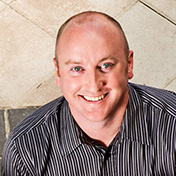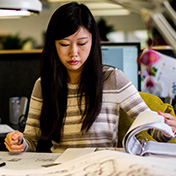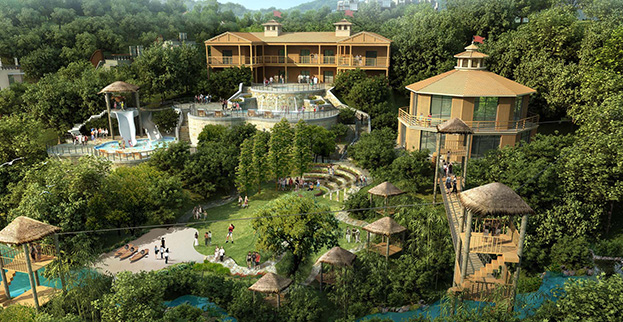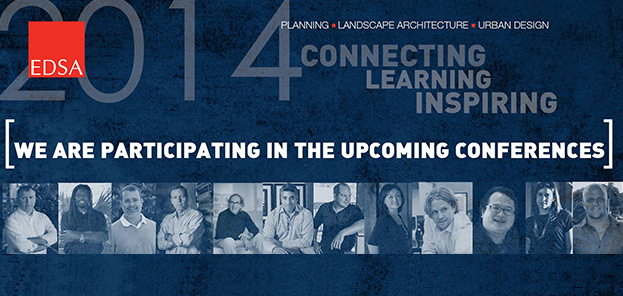With indirect communication growing by leaps and bounds and more of our daily life taking place in the private sphere – in our homes, at our computers, in our cars – it seems logical that public city spaces should have a new and influential role. For exercise and well-being, an important catalyst for economic development and a stimulus for breathing life into neighborhoods, the most cherished form of public infrastructure is green spaces – serving as an open-air living room and outdoor leisure center.
A study by the Commission for Architecture and the Built Environment revealed that nine out of ten people use local parks and green spaces while an additional 40% travel in excess of 10 miles to visit local parks for recreation. We all understand the benefits of fresh air and a change of scenery, however, urban green spaces also encourage biodiversity, aid economic development and combat the effects of climate change.
Social Benefits. Well-designed urban open space helps city dwellers balance their lives offering a refuge from the bustle, opportunities for learning and a place to gather with family and friends.
Public Health Benefits. Representing a powerful weapon in the fight against obesity and ill-health, parks help improve physical and mental health by encouraging us to walk, to play, or simply to enjoy the natural environment.
Economic Benefits. With increasing competition to attract investment, the presence of good public green space becomes a vital marketing tool and offers very clear benefits to the local economy by stimulating increased home prices and retail traffic.
Environmental Benefits. Vegetation can dampen noise levels, filter pollution, absorb carbon dioxide, absorb rainwater, reduce run-off and provide shade. Additionally, green spaces offer refuge for threatened species and buffers against the impacts of climate change.
Aesthetic Benefits. Green spaces provide a refreshing contrast to the shape, color, and texture of buildings – stimulating the senses with organic colors, sounds, smells and motions.
The need for public green space will only become more acute as the world population increases. To meet these needs, we must continue to create and renovate destination parks as well as upgrade our streets and sidewalks. Because vibrant public parks support biodiversity, we must increase the health and vitality of natural areas by expanding investment in and stewardship of these great spaces.
If both public and private interests work together, we can help more people experience the joys of jogging down a tree-lined path, of a family picnic on a sunny lawn or sharing a community garden’s proud harvest. We can create urban destinations that offer refuge from city streets allowing us to rediscover our natural roots and reconnect with our souls.
meet the faces of edsa



With a passion for golf course design, Brandon steered his career toward Landscape Architecture. He joined EDSA after earning his Bachelors in this field from The Ohio State University and has been a member of the Linquist Studio in Orlando since early 2005. A thoughtful and optimistic designer, Brandon’s creativity truly blossoms when faced with a puzzling set of project constraints. Affectionately called “Sherlock” by his studio mates, Brandon revels in finding an imaginative, yet implementable solution to any challenge. His aptitude with hand graphics allows him to quickly depict ideas on paper as a visual expression of his design concepts. A native of Cleveland, Brandon aspires to one day be involved in the revitalization of his home town with a planning approach that restores the city to its former glory.
As an introduction into the field of architecture and engineering, James spent the summers of his youth working alongside his father, a general contractor, building and framing custom homes. Combined with a love for horticulture and sustainability, James pursued a Bachelor in Landscape Architecture from the University of Kentucky. He joined EDSA in 2012 and has had the good fortune to collaborate with several studios on a spectrum of projects. Exposure to diversity in industry, location, scope and size has allowed James to grow as a well-rounded and versatile designer. He is passionate about creating intelligent, outdoor spaces which contribute to society’s quality of life. A current member of the Gray Studio, James’ holistic approach is rooted in the connection between creativity, community, craft, place, performance, aesthetics and sustainability.
Kuo vividly remembers the beautiful tropical gardens of Southeast Asia and the sense of intimacy and vintage feel created by the smallest details. She relates to classic materials and the sense of comfort achieved by integrating elements of history, culture and context. She has always enjoyed the feeling of holding a pen and drawing – realizing how the intrinsic movement allows for expression. Her designs reflect an emotional connection to place and she thrives on seeing her design intent achieved in form. Kuo strongly believes the firm’s work in China provides a consistent challenge to think outside the box and create spaces that reach beyond traditional solutions. With a Masters of Landscape Architecture from the University of Georgia, Kuo joined EDSA in 2011 and is a member of the LaMont studio.

The best designs are inspired by a collaboration that celebrates the nature and cultural attributes of place.
studio insight
Ecotourism is being heralded as a new wave of global consciousness by encouraging travelers to tread lightly on – or even give back to – the environment and communities they visit. Although not an entirely new concept, the current application is based on combining the elements of environmental conservation, tourism and bridging cultural understanding.
In working with Regalia Hotel Group, the Lalli Studio has master planned the Andaman Moganshan resort to protect, preserve and enhance environmental and cultural components – portraying the strength and elegance of the land as well as cultivating life-enhancing, transformative experiences. In order to achieve minimal impact, only 4% of the 49 hectares has been strategically selected for development. Besides providing a connection to the existing topography and vegetative canvas, an overriding goal was to utilize existing structures and enhance them for public use. Additionally, emphasis was placed on passive outdoor activities for families, as well as on didactic opportunities to learn about the local agriculture and farming techniques. Both of these endeavors will take place in carefully protected fruit orchards, bamboo forests and terraced tea gardens. The resort is targeted to achieve the LEED Platinum and China 3-Star Energy ratings.
For more information on the Lalli Studio visit
http://www.edsaplan.com/en/Team/Studios/Lalli
We are pleased to be participating in several upcoming, innovative conferences that address investment and development topics related to North America, China, the Caribbean, Europe and Latin America. Conferences provide us with a unique opportunity to network with other industry professionals and improve our educational knowledge through informative sessions, discussions and sharing of perspectives on issues affecting real estate development. Our objective is to stay abreast of what’s trending, explore emerging markets and evaluate what is working and what isn’t, so that we can apply this insight to future endeavors. Let us know if you are attending any of these upcoming events to connect with an EDSA colleague.
To learn more, visit our Facebook page: http://on.fb.me/1g8O3Be




